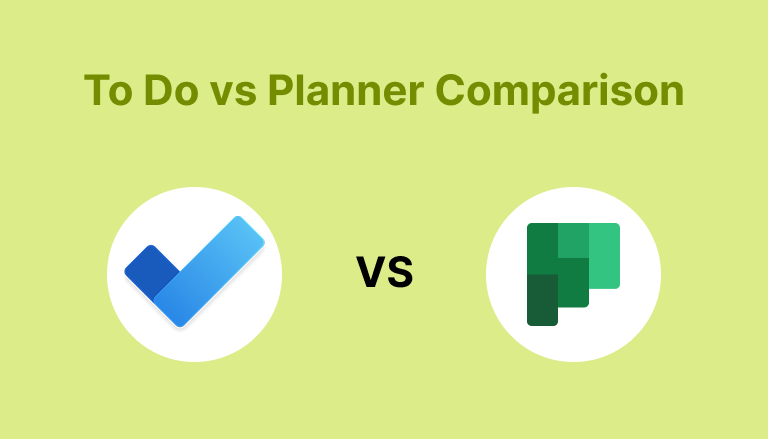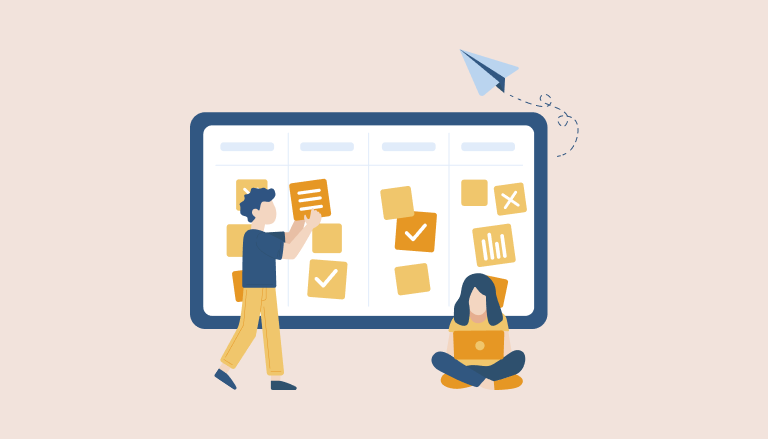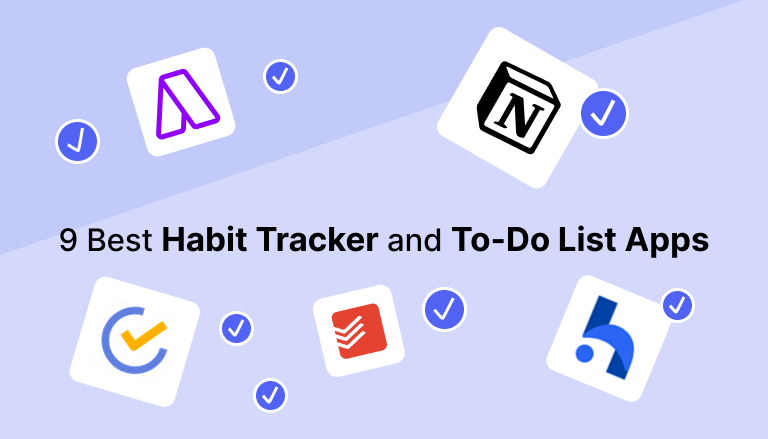Building better habits and managing daily tasks are two of the most effective ways to improve productivity. Yet many professionals struggle to stay consistent—not because they lack motivation, but because they lack the right system.
Digital tools can help. People who regularly use to-do lists are 38% more likely to manage their time effectively. And with the average adult creating over 156 to-do lists a year, it’s clear that structured task management is a common need.
On the habit side, consistency is the challenge. Research shows it takes 59 to 66 days on average to form a new habit, and sometimes up to a year for it to become automatic. That’s why habit-tracking apps are seeing rapid growth—projected to grow from $11.4 billion in 2024 to $38.3 billion by 2033.
The key is finding the right app—one that not only tracks your habits or tasks, but actually helps you follow through. In this blog, we’ll explore the top apps for tracking habits and managing to-dos—helping you build habits and get things done, all in one place.
Before you choose the right tool, it’s important to understand what makes a productivity app truly effective.
What Are the Best Habit Tracker and To-Do List Apps?
The best habit tracker and to-do list apps aren’t just about ticking boxes or logging streaks—they’re systems that support consistency, structure, and execution. They help you build good habits and make sure those habits (and tasks) actually fit into your day.
An effective app should reduce friction. It should make it easier to capture ideas quickly, prioritize tasks clearly, track your progress visually, and stay on schedule. It’s not just about managing what you have to do—it’s about giving you the mental clarity to focus on what matters most.
While features vary, the most useful apps share a few key traits:
- They’re intuitive and fast to use
- They sync across devices and calendars
- They support flexible scheduling and recurring tasks
- They offer visual feedback like progress charts or streaks
- And most importantly, they help you follow through
Now that we’ve outlined what great productivity tools should deliver, let’s look at the specific criteria that separate the best from the rest.
Criteria for Selecting the Best Apps
Choosing the right habit tracker or to-do list app isn’t just about looks or popularity—it’s about finding a system that helps you stay consistent, focused, and in control of your time. Below are the essential criteria that define a high-quality productivity app:
1. User-Friendly Interface
A cluttered or confusing interface can become a barrier to daily use. The best apps are intuitive and clean, allowing you to quickly add tasks, review progress, and navigate features without friction.
2. Cross-Platform Integration
In today’s work environment, productivity happens across devices and apps. A good tool should sync seamlessly between desktop and mobile, and ideally integrate with your calendar, communication tools, and task sources.
3. Habit Analytics
Tracking progress is a proven way to stay motivated. Look for features that provide data on streaks, completion rates, trends, and performance over time—so you can see where you’re improving and where you need to adjust.
4. Customization and Flexibility
Your system should fit your lifestyle—not the other way around. Whether it’s adjusting habit frequency, organizing tasks by priority, or using custom tags and views, flexibility ensures the tool adapts to your workflow.
5. Reminders and Notifications
Timely reminders are key to staying on track. The most effective apps offer smart, unobtrusive notifications to help you remember important tasks and keep your habits top of mind—without becoming a distraction.
With those criteria in mind, let’s explore some of the top apps that meet these standards and support both habit-building and task management.
Top Habit Tracker and To-Do List Apps
With dozens of productivity tools available, finding the right one can be overwhelming. Below are some of the most effective habit tracker and to-do list apps available today—each meeting the core criteria of usability, integration, analytics, flexibility, and reminders.
1. Akiflow
Akiflow combines task management, time blocking, and smart scheduling in one powerful platform. Unlike traditional habit trackers, it lets you actually schedule habits into your daily calendar—turning good intentions into real time commitments. You can capture tasks from tools like Slack, Gmail, Notion, and Asana, then drag and drop them into your calendar for execution.
Key Features:
- Time-blocking for both habits and tasks
- Fast task capture with keyboard-first UX
- Google Calendar and Outlook integration
- Smart notifications and AI-assisted prioritization
- Centralized command center for tasks from multiple tools
Ideal for: Professionals who want to schedule habits and tasks directly into their calendar
Platform: macOS, Windows, Web
2. Habitify
Habitify focuses solely on habit tracking with a sleek interface and excellent analytics. You can group habits, set goals, and view completion trends over time. It’s especially useful for those who want to build simple routines and see how consistently they follow through.
Key Features:
- Clean, distraction-free design
- Daily/weekly/monthly progress reports
- Custom habit frequencies
- Light/dark mode and habit grouping
- Reminder scheduling
Ideal for: Users who want a clean, minimalist habit tracker with visual progress
Platform: iOS, Android, Web
3. Streaks
Streaks encourage habit-building by helping you maintain unbroken chains of behavior. With full Apple Health integration, it’s a great fit for fitness and wellness goals. You can track up to 12 habits at a time, and the app’s visual interface makes it easy to stay motivated.
Key Features:
- Focuses on streak consistency
- Apple Health integration
- Daily reminders
- Custom icons and themes
- Widget support for quick access
Ideal for: iOS users who want to build strong daily habits
Platform: iOS, macOS
4. TickTick
TickTick blends habit tracking with robust task management. You can create recurring habits alongside your regular tasks, view everything in a calendar or list view, and even use the built-in Pomodoro timer for focused work sessions.
Key Features:
- To-do lists, habits, and calendar in one
- Custom reminders and recurring tasks
- Pomodoro timer built-in
- Cross-device syncing
- Priority levels and tags for task organization
Ideal for: Users who want an all-in-one task manager with habit tracking
Platform: iOS, Android, macOS, Windows, Web
5. Habitica
Habitica turns productivity into a game. Completing habits and tasks earns you XP and coins to upgrade your avatar and unlock in-game rewards. It’s especially helpful for people who want extra motivation and enjoy RPG-style progress.
Key Features:
- Gamified habit and task tracking
- Daily, weekly, and custom habit options
- Social accountability via teams and quests
- Level up, collect gear, and build streaks
- Task categories: habits, dailies, and to-dos
Ideal for: Users who are motivated by gamification and rewards
Platform: iOS, Android, Web
6. Loop
Loop is an open-source, lightweight habit tracker with a strong focus on data and simplicity. It tracks habit strength over time and provides weekly/monthly reports. It’s ideal for users who don’t need flashy visuals, just reliable tracking.
Key Features:
- No sign-up required and completely free
- Streak and habit strength metrics
- Offline functionality
- Detailed graphs and progress overviews
- Custom schedules (daily, every X days, etc.)
Ideal for: Android users looking for a free, analytics-rich habit tracker
Platform: Android
7. Todoist
Todoist is one of the most popular task managers, known for its clean interface and powerful organizational features. While not a dedicated habit tracker, it allows users to set recurring tasks (e.g. “meditate every day at 8am”)—making it a practical solution for managing habits within a task-centric workflow.
Key Features:
- Natural language input for fast task creation
- Recurring tasks and reminders (ideal for habits)
- Priority levels, tags, filters, and shared projects
- Productivity “karma” system to encourage consistency
- Cross-platform with seamless syncing
Ideal for: Task-first users who want to layer in light habit tracking
Platform: iOS, Android, macOS, Windows, Web
8. Notion
Notion is a flexible all-in-one workspace where users can build their own habit trackers, to-do lists, and goal systems. It’s not a traditional habit tracking app, but it offers total customization—making it ideal for advanced users who want to design their own workflows from scratch.
Key Features:
- Build custom habit trackers with databases
- Create templates for daily planning and weekly reviews
- Multiple views: calendar, kanban, gallery, list
- Team collaboration and content sharing
- Integrates with tools via third-party automations
Ideal for: Users who want full customization and control over their system
Platform: iOS, Android, macOS, Windows, Web
9. Microsoft To Do
Microsoft To Do is a lightweight, cloud-based task manager that syncs with Outlook and other Microsoft 365 tools. It’s ideal for users who want a minimalist interface with solid planning features, and who rely on Microsoft for email, calendars, or team collaboration.
Key Features:
- Daily “My Day” planning list
- Task reminders, due dates, and recurring options
- Subtasks and simple list organization
- Outlook and Teams integration
- Free and reliable cross-platform syncing
Ideal for: Users in the Microsoft ecosystem who want simple task and reminder functionality
Platform: iOS, Android, Windows, Web
While features vary across these platforms, they all share one thing in common: they’re designed to help you stay focused and consistent. But how exactly do they drive better results? Let’s break down the benefits.
Benefits of Using Habit Tracker and To-Do List Apps
Whether you’re building personal routines or managing a busy workload, habit and to-do apps offer more than organization—they bring structure, focus, and follow-through. Here’s how:
- Accountability Boost: Logging tasks and habits makes them harder to ignore. Reminders and deadlines drive consistent action.
- Motivation Through Progress: Streaks, checklists, and progress bars provide visual wins that keep you engaged and on track.
- Smarter Time Management: Scheduling tasks and habits (especially with time blocking) helps you plan proactively and cut down on decision fatigue.
- Clarity and Focus: Having everything in one place eliminates mental clutter and keeps you dialed in on what matters.
- Goal Alignment: Small daily habits compound into big wins. Tracking ensures your actions align with long-term goals.
These benefits are only unlocked when you use the tools intentionally. Here are a few ways to build lasting habits and stay productive using your chosen system.
Tips for Maximizing the Use of These Apps
Simply downloading a habit tracker or to-do list app isn’t enough. Like any tool, its effectiveness depends on how you use it. Here are some practical tips to help you get the most value out of your system and stay consistent over the long term:
Tip 1. Set Clear and Achievable Goals
Start small. Instead of “Exercise every day,” begin with “Stretch for 5 minutes after waking up.” Clear, specific habits are easier to track and stick with—especially when you’re building momentum.
Tip 2. Regularly Review and Adjust
Check in weekly or monthly to review your progress. Are certain habits not sticking? Are tasks piling up in certain areas? Make time to reassess and adjust so your system stays aligned with your real goals—not just your ideal ones.
Tip 3. Use Reminders and Notifications Wisely
Reminders are helpful—but only if they’re well-timed and purposeful. Don’t overload yourself with alerts. Instead, schedule nudges for key points in your day when you’re most likely to act on them.
Tip 4. Block Time for Key Habits
Rather than relying solely on streaks or checklists, schedule time for your most important habits directly into your calendar. This turns them from “things you hope to do” into actual appointments with yourself.
Tip 5. Integrate App Usage Into Your Routine
Use your app at the same time each day—morning planning, afternoon check-ins, or evening reviews. Consistent usage builds habit memory and makes the tool a natural part of your routine, rather than something you forget about.
Ultimately, the best app is the one that helps you take action consistently. Let’s wrap up with a final thought—and a proven recommendation to help you get started.
Final Thoughts
Building better habits and managing your tasks effectively isn’t about doing more—it’s about doing what matters with consistency and clarity. The right habit tracker or to-do list app can help you stay on track, reduce mental clutter, and make steady progress toward your goals.
But the most effective tools go beyond tracking. They help you integrate habits into your day, align your tasks with your time, and execute without distractions.
If you’re looking for a system that doesn’t just track what you need to do—but helps you follow through—Akiflow is built for you. With fast task capture, time-blocking, and integrations with your calendar and favorite tools, it gives you full control over your schedule and routines.Start your free trial of Akiflow and experience the productivity system designed for high-performance professionals.

Getting Things Done in 5 Steps: The Secret to Mastering Your Workflow
Master your workflow with the Getting Things Done method. Discover 5 simple steps to stay organized, reduce stress, and boost productivity.

Microsoft To Do vs Planner: Which Task Management Tool Is Right for You?
Compare Microsoft To Do vs Planner. Discover ideal scenarios for task management and team collaboration. Choose the right tool and boost productivity today!

Best Task Management Tools and Techniques for 2025
Boost efficiency with task management tools like ClickUp and Trello. Choose the right tool for your team, improve productivity, and reduce burnout. Explore now!
